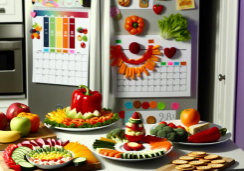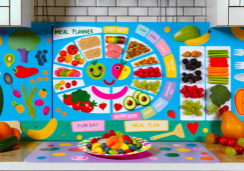Budget-Friendly Healthy Family Meal Planning Guide
In the realm of family nutrition, the cost of healthy eating often seems at odds with the family budget, yet you'll find that with a bit of strategy, they can indeed harmonize.
As you stand before your pantry, eyeing the staples and wondering how to transform them into a week's worth of meals, remember that a well-thought-out plan is your wallet's best friend.
You're about to uncover how to master the grocery sales cycle, introduce cost-effective meatless meals, and make the most of seasonal produce to benefit both your bank account and your family's health.
But the journey to frugal, nutritious eating doesn't end there; you'll also learn to give new life to leftovers in ways that will surprise and satisfy even the pickiest of eaters.
Stay tuned, because the secrets to eating well on a budget are just around the corner, ready to change the way you approach mealtime forever.
Assess Your Pantry Staples
Before you create your shopping list, take a thorough inventory of your pantry to identify staples you already have and what you'll need to buy. Meal planning is a strategic approach that fosters a healthy family lifestyle while also being cost-effective. Your pantry might already be stocked with nutrient-dense pantry staples that can serve as the backbone for numerous use meals. Check for items like canned black beans, an excellent source of protein and fiber, and brown rice, which provides whole grains.
Incorporating dried herbs can enhance flavors without adding sodium or fat, making your dishes healthier. Look for canned beans, including chickpeas and kidney beans, to add variety and nutrition to your meals. When grocery shopping, consider stocking up on budget-friendly proteins such as frozen fish, which can be a heart-healthy option.
Planning meals around these staples reduces the need for frequent shopping trips and helps prevent food waste. By using what's already in your pantry, you can ensure that your family enjoys balanced meals with a focus on whole foods. Keep these considerations in mind as you plan your week's meals and make the most of the ingredients you have on hand.
Master the Grocery Sales Cycle
Having assessed your pantry staples for meal planning, you can now focus on mastering the grocery sales cycle to further enhance your family's nutrition while keeping an eye on the budget. By understanding how to shop smart, you'll be able to craft a Budget Dinner Meal Plan that won't break the bank.
Here are some strategies to help you navigate the Weekly Grocery flyers for the best deals:
- Spot Discounted Proteins: A Week of Cheap family meals often hinges on protein costs. Look for sales on chicken, beef, or fish, and don't overlook eggs and canned tuna, which can be the backbone of a low-cost meal.
- Embrace Seasonal Produce: Fresh, seasonal fruits and veggies not only pack a nutritional punch but can also be more affordable. Incorporate these into your shopping list for vibrant, nutrient-dense family meals.
- Plan Meatless Nights: Designate nights for plant-based dinners. Lentils and canned beans offer protein at a fraction of the cost per serving, making them stars in your grocery budget.
- Get Creative with Leftovers: Stretch your meals by repurposing leftovers. A family of four can enjoy a new twist on last night's dinner or pack it for a nutritious lunch, ensuring nothing goes to waste.
Embrace Meatless Mondays
Regularly incorporating Meatless Mondays into your family's routine can lead to significant savings on grocery bills while also offering a variety of health benefits. By setting aside one day a week for vegetarian dinners, you're not only reducing your reliance on often pricey meats like ground beef, but you're also opening up your palate to a whole new world of flavors and nutrients.
As you craft a week of healthy meals, consider building your meal plan around plant-based proteins. Legumes, such as lentils and canned chickpeas, aren't only affordable but are also packed with fiber and essential nutrients. These versatile ingredients can transform into hearty dishes that'll leave your family both satisfied and nourished.
Imagine a Veggie Taco night where everyone builds their own creations with an array of colorful, crunchy vegetables and spiced chickpeas — a budget family meal that's both fun and wholesome. By embracing Meatless Mondays, you're not just figuring out a meal plan to feed your family; you're also instilling healthy eating habits that contribute to their long-term well-being.
Ultimately, your healthy meal plan will benefit your wallet, your health, and the environment, proving that you can indeed feed your family well on a budget.
Plan Meals Around Seasonal Produce
While embracing Meatless Mondays is a step towards a healthier diet, planning your family's meals around seasonal produce can further enhance nutritional value and cost savings. By aligning your meal prep with what nature provides, you're not only getting the most flavor and nutrients but also doing your budget a favor.
Consider these steps to integrate seasonal vegetables and fruits into your family meal planning:
- Seek Weekly Deals: Spot the discounts on seasonal produce at your local market, and plan meals that make the most of these affordable options.
- Theme Your Meals: Match your weekly meal themes with the seasonal availability of produce. This can be a fun and educational way to explore different cuisines while enjoying peak freshness.
- Adjust Recipes: Don't hesitate to tweak your go-to recipes to include in-season vegetables and fruits. This ensures variety and helps minimize food waste.
- Educate Your Choices: Know which produce is in season and plan your healthy dinners accordingly. This knowledge can be a powerful tool for both nutrition and savings.
Incorporate Leftovers Creatively
Transforming leftovers into new, exciting dishes not only saves money but also ensures you're making the most of available nutrients and reducing food waste. As you delve into meal planning, think about how you can creatively incorporate leftovers into your next day's menu. This approach isn't only budget-friendly but also promotes a healthy variety in your meals.
For instance, repurpose last night's roasted chicken or tofu into a vibrant salad or a hearty wrap for lunch. This not only uses up the last of your cooked proteins but also adds a fresh twist to your meal plans. Leftover veggies can find a new life in a nutritious stir-fry or as a flavor boost in a one-pot soup, ensuring you minimize food waste while keeping meals exciting.
Leftover grains like rice or pasta are incredibly versatile. Whip up a quick frittata, adding in leftover veggies for a nutrient-packed meal that's easy on your wallet. Or, toss them into a grain bowl with some fresh greens and a drizzle of dressing for a balanced lunch.
Through these inventive uses of leftovers, you'll sustain a healthy, budget-conscious kitchen that respects both your body and the planet.
Frequently Asked Questions
How Can I Feed My Family Healthy on a Budget?
To feed your family healthily on a budget, you'll want to master smart shopping, buy seasonal produce, and bulk items. Use coupons, grow a garden, and explore community markets for nutritional balance and savings.
How Do I Make a Healthy Meal Plan on a Budget?
You'll make a healthy meal plan on a budget by smart shopping, buying seasonal produce in bulk, and meal prepping. Include nutritious snacks, hunt discount deals, rotate recipes, and drink plenty of water.
How Do I Plan a Healthy Family Meal?
To plan a healthy family meal, focus on nutrition essentials and dietary balance. Shop seasonally, use batch cooking, and practice smart storage. Incorporate garden harvests, visit farmers' markets, and manage portions with meal prepping.
How Do You Feed a Family of 7 on a Tight Budget?
You can feed a family of 7 on a tight budget by bulk buying, using coupons, and choosing seasonal produce. Try meal prepping, growing a garden, and organizing potluck dinners to save more.
Conclusion
You've got the tools to whip up nutritious, budget-friendly meals for your family. Remember, your pantry is your ally; use it wisely. Keep an eye on those sales and cycle your buys.
Meatless Mondays aren't just trendy, they're smart and good for your wallet and health. Seasonal produce adds flavor and nutrients at a lower cost. Get inventive with leftovers to extend their life.
Plan well, and you'll enjoy healthy eating without breaking the bank.










